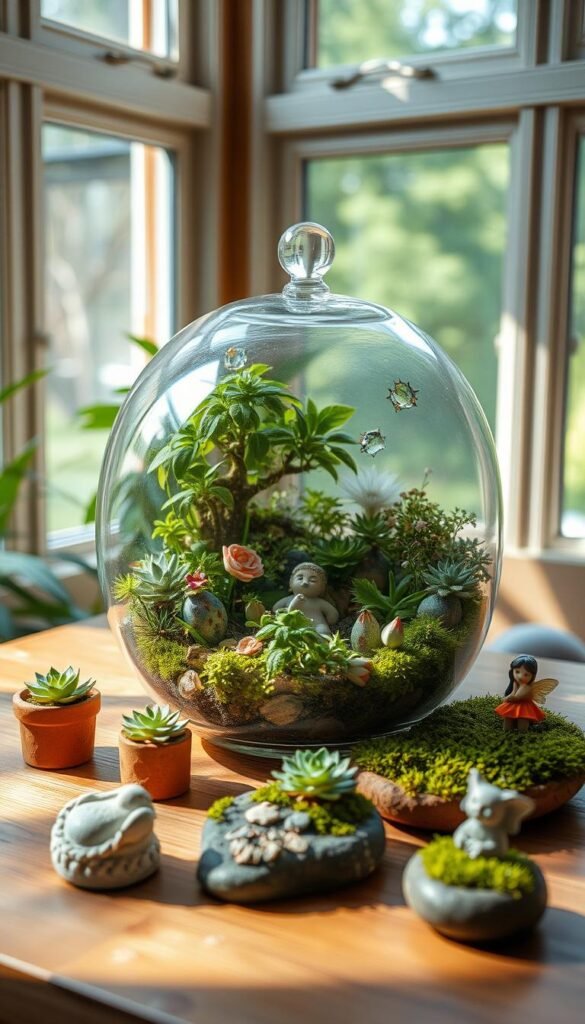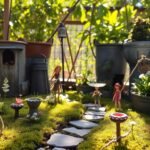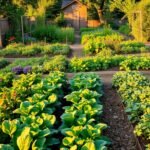Imagine creating tiny worlds that spark joy in every corner of your house. These delicate displays let you design year-round enchantment without battling harsh weather or hungry critters. Whether you’re crafting for relaxation or family fun, miniature landscapes offer endless possibilities.
Unlike outdoor projects, your creations stay safe from sun damage or rain. Delicate trinkets and tiny figurines thrive indoors, letting you experiment with fragile materials. You can refresh designs seasonally or keep a permanent slice of wonder on a shelf.
Small containers become portals to magical realms. Clear glass vessels showcase layered textures, while shallow dishes let you build sprawling scenes. Add soft lighting or miniature furniture to amplify the storybook vibe.
These displays brighten dim windows or add personality to empty nooks. They’re perfect for apartments, offices, or homes needing a touch of playfulness. Best of all, you don’t need a green thumb—succulents and air plants thrive with minimal care.
Ready to turn everyday items into something extraordinary? Let’s explore how simple containers can become homes for imagination.
Unleash the Magic of Indoor Fairy Gardens
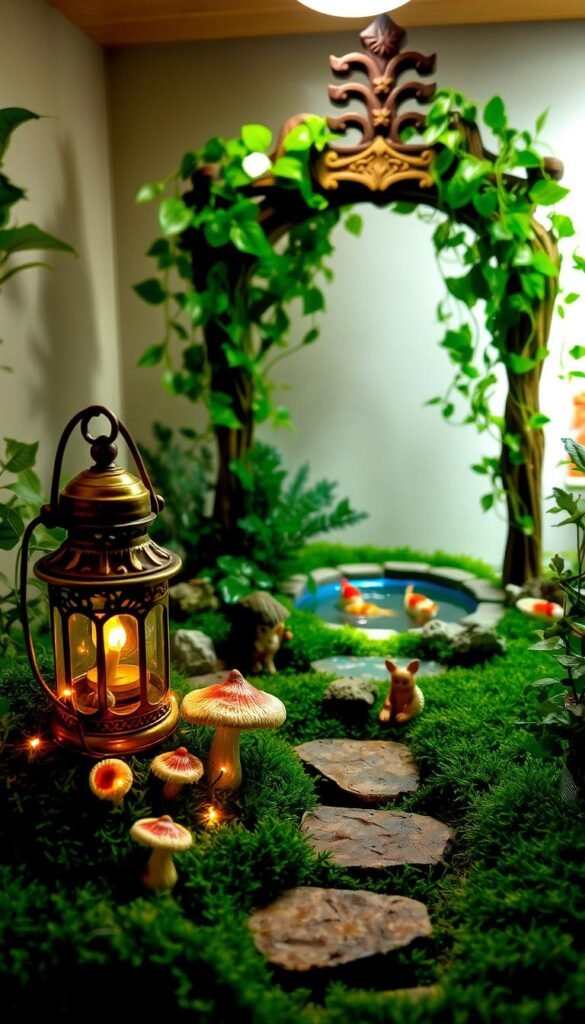
Why limit wonder to storybooks? Tiny enchanted displays bring daily doses of delight to coffee tables, bookshelves, or kitchen counters. These pocket-sized escapes invite you to pause and explore whimsical narratives through miniature details.
Why Bring Fairytale Charm Indoors?
Miniature green spaces thrive inside for three reasons:
- Spark joy with textures like velvety moss or glittering pebbles
- Encourage storytelling through tiny bridges and hidden pathways
- Offer mindful relaxation while arranging delicate elements
Adults rediscover childhood curiosity, while kids learn caregiving through tending tiny plants. One study found arranging small objects reduces stress by 28%—proof that magic impacts well-being.
Creating a Welcoming Miniature Haven
Start with a shallow dish or wide-mouthed vase. Layer materials to build depth:
- Pebbles for drainage
- Potting soil for plant roots
- Ground cover like preserved sheet moss
Add personality with hand-painted stones or a “fairy door” against a tree root. Rotate seasonal accents—autumn leaves in October, miniature snowdrifts in December. Your creation evolves while keeping the enchantment fresh.
Explore Unique Containers for Your Fairy Garden
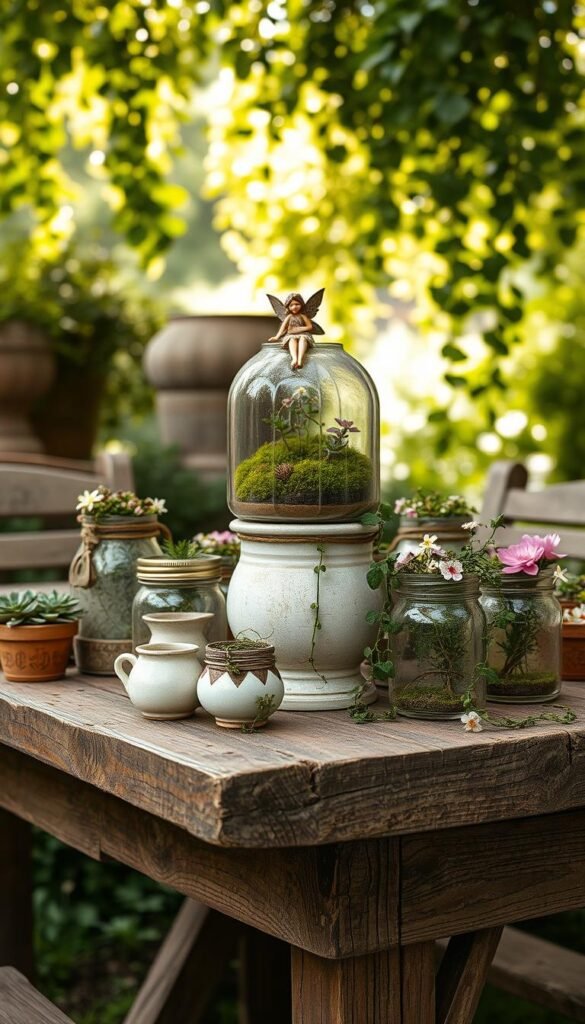
Your tiny landscape deserves a home that matches its charm. Second-hand treasures like chipped teacups or weathered boxes add instant character. These finds often cost less than store-bought pots while offering one-of-a-kind appeal.
From Vintage to Upcycled Finds
Hunt for containers at thrift stores or estate sales. Look for items with interesting textures—rusted metal tins, cracked ceramic bowls, or repurposed wooden crates. These pieces whisper stories through their scratches and patina, giving your creation depth before you add a single plant.
Merging Functionality with Fantasy
Choose vessels that work as hard as they charm. Ensure containers have drainage holes or add a gravel layer to prevent root rot. Pair practical features with whimsical details—a colander becomes a hanging planter, while an old clock case turns into a layered scene.
| Container Type | Best Features | Style Match |
|---|---|---|
| Antique Teapots | Built-in spout for water flow | Cozy cottage |
| Vintage Toolboxes | Multiple compartments | Industrial chic |
| Glass Apothecary Jars | Clear visibility | Enchanted forest |
Mix materials for visual contrast—smooth porcelain against rough bark, or shiny copper beside matte stone. Your container becomes the first chapter in your miniature world’s story.
Fairy Garden Ideas Indoor: Transform Mason Jars, Terrariums, and Bowls

Glass vessels offer a clear canvas for crafting magical, self-sustaining ecosystems. A simple mason jar becomes a stage for tiny forests when layered with pebbles, soil, and moss. Add miniature benches or a winding pebble path to invite storytelling moments.
Start by placing drought-tolerant plants like succulents near the jar’s opening for easy care. Use tweezers to position delicate accents—think tiny mushrooms or a ceramic cottage. These compact scenes thrive on desks or windowsills, catching sunlight like nature’s snow globes.
Terrarium-style containers create humid environments perfect for ferns and air plants. Layer materials strategically: charcoal keeps the soil fresh, while sphagnum moss retains moisture. This setup mirrors the principles of DIY hydroponic projects, blending science with fantasy. A well-crafted terrarium becomes a low-maintenance slice of enchantment.
Shallow dishes let you design sprawling landscapes. Arrange driftwood as bridges or use blue gravel for miniature streams. Rotate seasonal decor—pumpkins in fall, glittery snowflakes in winter—to keep the magic alive year-round.
Every vessel holds potential. Whether it’s a repurposed spice jar or a thrifted bowl, your creativity turns ordinary items into portals of wonder.
Terrarium Treasures for a Miniature Wonderland

Glass-domed worlds invite you to craft living art that thrives with minimal effort. These enclosed ecosystems let you design self-contained magic where every detail shines through crystal-clear walls. Perfect for busy lifestyles, they combine natural beauty with fuss-free maintenance.
Designing with Air Plants and Moss
Start by selecting tillandsias—their twisty shapes add drama without needing soil. Nestle them between stones or hang them from driftwood. These hardy plants absorb moisture through their leaves, making them ideal for tight spaces.
Spread sheet moss across the base to mimic forest floors. It conceals potting mix while adding velvety texture. For depth, layer different moss varieties—pillow moss works for hillsides, while mood moss creates shadowy nooks.
| Plant Type | Light Needs | Watering |
|---|---|---|
| Air Plants | Bright indirect | Mist weekly |
| Sheet Moss | Low light | Spray monthly |
| Fern Variety | Filtered sun | Water biweekly |
Maintain humidity by lightly misting every 7-10 days. Keep decorative elements like resin benches away from direct spray to prevent discoloration. Rotate accessories seasonally—tiny pumpkins in fall, glittering icicles in winter—to keep your mini scene fresh.
Add height with stacked stones or cork bark. Drape preserved vines over branches to create canopy effects. Your terrarium becomes a conversation piece that grows more charming with time.
Whimsical Teacup and Enamel Basin Designs
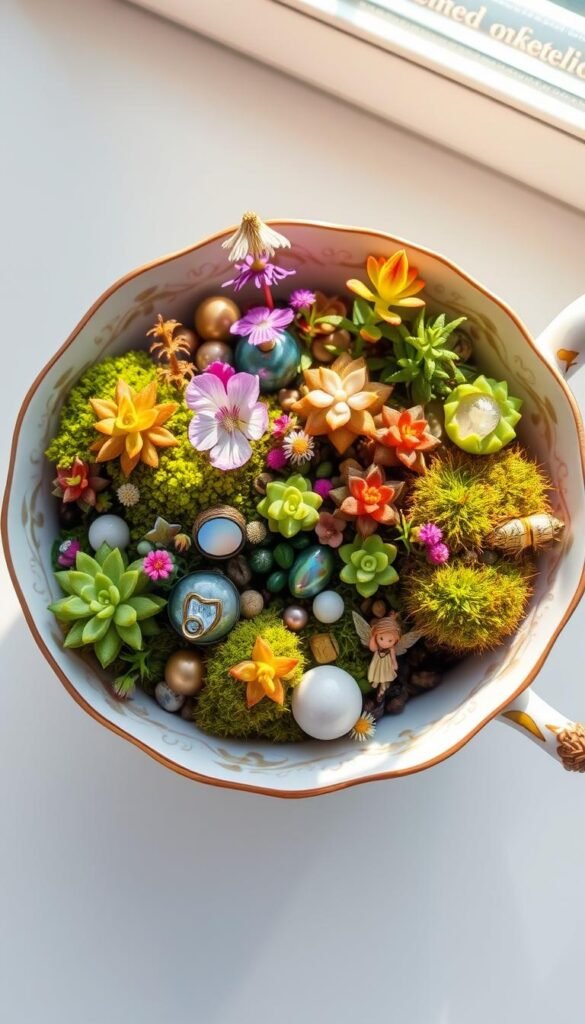
Turn forgotten dishware into tiny realms of wonder. Vintage teacups and enamel basins breathe new life as charming homes for miniature scenes. Their compact size makes them ideal for windowsills or desks, blending nostalgia with greenery.
Crafting Your Own Teacup Fairy Garden
Start by choosing a cup with personality—floral patterns or gilt edges add instant charm. Layer pebbles at the bottom for drainage, then add cactus soil. Nestle small succulents like echeveria or sedum into the space. These plants thrive in shallow conditions and need minimal watering.
Enamel basins offer room for creativity. Their wide surface lets you build winding paths between thyme clusters or position a tiny bench under a faux willow tree. Use preserved moss as carpeting to keep maintenance low.
| Feature | Teacups | Enamel Basins |
|---|---|---|
| Size | 4-6 inches wide | 10-14 inches wide |
| Plant Capacity | 1-2 small succulents | 3-5 mixed varieties |
| Drainage Solution | Pebble layer | Gravel base |
| Styling Theme | Storybook charm | Vintage farmhouse |
You can repurpose thrifted finds into drainage-friendly containers. Drill holes in metal basins or line porcelain cups with activated charcoal. Display finished pieces on floating shelves or as centerpieces—their whimsy sparks conversations wherever they sit.
Creative Upcycled Ideas: Birdcages and Old Suitcases
Abandoned treasures hold untold stories waiting to unfold. Vintage birdcages and weathered suitcases become stages for enchanted narratives when reimagined as miniature displays. These unexpected containers add depth to your décor while giving discarded items new purpose.
Repurposing Everyday Items
Transform birdcages into vertical wonderlands. Their wire frames let you hang tiny lanterns or wind chimes between ivy vines. Use the cage’s tiers to create levels—mossy platforms below, air plants dangling above. This design approach turns forgotten metalwork into living art.
Old suitcases offer portable storytelling spaces. Line the base with waterproof sheeting before adding soil. Build rolling hills using preserved moss, then position miniature travel trunks beside a “campfire” made of twigs and orange beads. These mobile scenes suggest journeys through imaginary realms.
| Container | Key Feature | DIY Tip |
|---|---|---|
| Birdcage | Vertical space | Attach climbing plants |
| Suitcase | Portability | Add handles for hanging |
Prepare containers properly for plant health. Drill drainage holes in suitcase corners or layer pebbles beneath soil. Seal wooden surfaces with non-toxic varnish to prevent rot. Your vintage finds become durable homes for delicate accessories and greenery.
Match your scene to the container’s history. A 1920s birdcage might host art deco benches, while a military trunk could feature tiny maps and compasses. These details turn simple crafts into conversation-starting displays that spark wonder daily.
Bringing Nature Indoors with Bonsai and Flowerpot Fancies
Bonsai trees bring ancient forests to your living room, their twisted trunks whispering stories of timeless landscapes. These living sculptures anchor your miniature worlds while serving as natural treehouse foundations for tiny figurines. Pair them with flowering plants to create scenes that blend artistry with horticulture.
Choosing the Perfect Mini Plants
Select bonsai varieties like juniper or ficus for their manageable size and sculptural appeal. Their gnarled branches become instant climbing frames for fairy ladders or swings. Complement them with peace lilies—their broad leaves create lush backdrops while thriving in low-light corners.
Prioritize soil quality for healthy roots. Mix akadama clay with pumice for bonsai, ensuring proper drainage. For flowerpots, use cactus soil blended with perlite to prevent waterlogging. This foundation keeps your mini ecosystem thriving beneath decorative pebbles or moss.
Integrating Rustic and Modern Elements
Balance weathered wood planters with sleek ceramic pots for visual contrast. Try these pairings:
- Rustic: Driftwood benches beside bonsai trees
- Modern: Geometric metal accents in terracotta pots
Upcycle vintage containers into functional art. An old toolbox becomes a tiered planter—bonsai on top, trailing ivy below. Add miniature stone pathways between plants to unite different textures. Your creation becomes a bridge between earthy charm and contemporary design.
Crafting Your Own Fairy Accessories and Details
Unlock endless storytelling possibilities by handcrafting elements that transform ordinary displays into personalized realms. Tiny touches you create become the soul of your miniature worlds, inviting viewers to imagine secret histories and hidden adventures.
Designing Miniature Entryways and Characters
Shape polymer clay into arched doors with textured “wood grain” using a toothpick. Bake creations at 275°F for 15 minutes—they’ll withstand indoor humidity while keeping their storybook charm. Pair these with twig ladders or pebble pathways for cohesive scenes.
Everyday materials shine when repurposed creatively:
- Popsicle sticks become picket fences with whitewash paint
- Wine corks transform into mushroom stools
- Acorn caps serve as rustic bowls
| Material | Best For | Durability Tip |
|---|---|---|
| Polymer Clay | Furniture, dishes | Seal with matte varnish |
| Natural Twigs | Bridges, ladders | Bake at 200°F to dry |
Pro Tip: Mix materials for depth—a clay cottage with a birch-bark roof feels authentically whimsical. “Handmade details become family treasures,” notes artisan Lila Matthews. “Children remember who built each tiny bench or lantern.”
Seal painted accessories with clear acrylic spray to prevent chipping. Rotate seasonal pieces—a pumpkin patch in fall, ice-skating pond in winter—to keep your diy creations feeling fresh year-round. These custom touches turn simple displays into legacy projects that spark joy for generations.
Luminous Touches: Fairy Lights and Indoor Lantern Ideas
Create enchanting nighttime displays that captivate even after the sun sets. Soft glows turn ordinary scenes into dreamlike escapes, highlighting delicate textures and hidden pathways. With clever placement, your tiny worlds gain new depth and drama when daylight fades.
Setting the Mood with Ambient Lighting
Battery-powered LED strings mimic fireflies dancing around mossy hills. Tuck them under miniature bridges or wrap them around tiny trees for a starry effect. These energy-efficient options last weeks on a single charge, letting you enjoy the magic without constant upkeep.
Glass lanterns serve dual roles—containers and light sources. Place a tea light inside to cast warm patterns on surrounding plants and decor. For adjustable brightness, choose models with dimmer switches. Position them near seating areas to create cozy reading nooks for your tiny residents.
Experiment with color to shift your scene’s vibe. Cool white bulbs evoke moonlit forests, while amber tones suggest candlelit cottages. Avoid overpowering hues—soft pastels maintain the delicate balance between fantasy and realism.
Strategic placement directs attention to key features. Angle lights toward miniature waterfalls or glowing windows for dramatic shadows. Rotate displays seasonally—twinkling icicles in winter, golden harvest bulbs in fall. Your illuminated creations become conversation starters that shine day and night.
Innovative Displays: Glass Cases and Cloche Techniques
Step into a world where delicate scenes stay pristine under crystal-clear protection. Glass cases and bell-shaped cloches turn fragile arrangements into timeless showcases. These enclosures guard against curious pets while creating ideal growing conditions for tender mosses and miniature ferns.
Showcasing Your Magical Miniature Scene
Museum-style displays let you craft intricate worlds without worrying about dust. The sealed environment acts like a tiny greenhouse, maintaining humidity for fussy plants. You can add lace-winged butterflies or paper-thin mushrooms too delicate for open-air setups.
Victorian-inspired cloches bring 19th-century charm to modern spaces. Their curved glass magnifies details while preventing moisture buildup. Place yours over a bed of reindeer moss dotted with porcelain cottages—it’ll feel plucked from an English conservatory.
Prevent foggy interiors by cracking the lid slightly during watering. For taller cases, add a hidden computer fan to circulate air. This keeps your scene crisp and mold-free, even in humid kitchens or sunrooms.
Elevate simple crafts to gallery-worthy art with layered lighting. Position LED strips beneath the base to illuminate winding pebble paths. Your creation becomes a conversation piece that blends horticulture with storytelling magic.
Dynamic Layouts: Designing with Mixed Containers
Craft a living storybook by blending diverse containers into one enchanting tableau. Repurposed china cabinets become bustling hubs for tiny communities, each shelf hosting unique scenes with miniature houses and shops. Mix tall vases with shallow trays to build depth, letting your imagination flow across different levels.
Rotate elements with the seasons—autumn leaves in wooden crates, spring blooms in glass domes. Your display stays fresh while keeping a unified theme through color schemes or recurring pathways that connect your fairy village. This approach turns separate pieces into chapters of a storybook narrative, blending gardening creativity with visual storytelling.
Balance is key. Pair vertical planters with low, wide dishes to create visual rhythm. Combine rough-hewn stone pots with smooth ceramic vessels for textural contrast.
These intentional pairings guide the eye while making each element shine. Tiny houses dot the landscape near “water features” made of blue gravel, while market stalls line pebble streets. This style of creative gardening invites you to think big by working small, crafting lively worlds where fairy communities flourish and villages expand.
